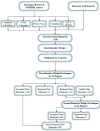Determining the minimum data elements to develop a child malnutrition registry system
- PMID: 39736636
- PMCID: PMC11684282
- DOI: 10.1186/s12911-024-02771-1
Determining the minimum data elements to develop a child malnutrition registry system
Abstract
Background: Today, malnutrition is one of the biggest health crises for children in the world. Access to accurate and high-quality data is very important to establish policies to deal with it. Registries are considered valuable tools for data collection and management of child malnutrition. Designing a dataset is the first step toward developing a registry system.
Objective: This study aimed to determine the minimum data elements for the Child Malnutrition Registry System (CMRS).
Methods: In this descriptive and cross-sectional study, firstly, data elements were extracted from reviewing scientific papers, reviewing existing systems, and conducting interviews with experts. Then, the extracted data elements were validated using an expert panel and Delphi technique. The criterion for accepting the final data elements in the registry system was based on a collective agreement, and it was when 75% of the experts collectively agreed upon a particular data element.
Results: A dataset was designed using the determined minimum data elements, including administrative data elements with three sub-categories (demographic, socioeconomic, and healthcare providers) and clinical data elements with 11 sub-categories (medical history, anthropometric indicators, clinical examination, nutritional data, physical activity and sleep, lab tests, para-clinical tests, diagnosis, complications, care procedures, life status, and follow-up). The number of final data elements in administrative and clinical categories were 47 and 251, respectively.
Conclusion: A comprehensive and accurate dataset provides conceptual structures that are the basis for developing the children's malnutrition registry system. The result of this study can fill the existing gaps in collecting, storing, and analyzing child malnutrition data. Furthermore, it can play an effective role in creating a successful strategic plan for improving child malnutrition.
Keywords: Children; Dataset; Delphi technique; Malnutrition; Registry system.
© 2024. The Author(s).
Conflict of interest statement
Declarations. Ethics approval and consent to participate: Ethical approval for the study was obtained from the Ethical Committee of Iran University of Medical Sciences (IR.IUMS.REC.1397.1083). All methods were carried out in accordance with relevant guidelines and regulations. Informed consent was obtained from all participants. Consent for publication: Not applicable. Competing interests: The authors declare no competing interests.
Figures
References
-
- Levels and trends in child malnutrition: UNICEF/WHO/World Bank Group joint child. malnutrition estimates: key findings of the 2023 edition. World Health Organization [internet].[cited 2023 November 11]. https://www.who.int/publications/i/item/9789240073791
MeSH terms
LinkOut - more resources
Full Text Sources
Medical
Miscellaneous


